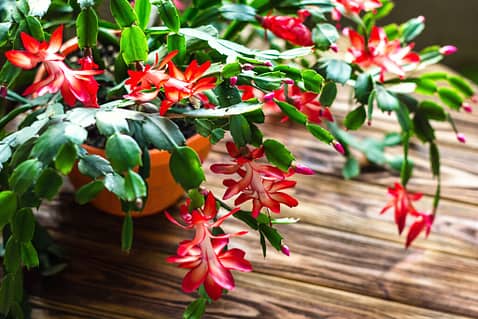HousePlantJoy is supported by our audience. When you purchase through one of our links, we may earn a small affiliate commission. As an Amazon Associate I earn from qualifying purchases. Your cost is not affected.
==================
Christmas Cactus is a succulent houseplant that blooms mostly during winter. It is a well-known indoor plant that is easy to care for and propagate. During its flowering, it blooms tubular pink or lilac flowers. No wonder why many people use them as special holiday gifts for their family and friends.
If you received a Christmas Castus gift, you might be wondering: How to care for Christmas Cactus and get them to bloom?
In this blog, you will learn more about Christmas Cactus, how to plant them, when to water them, and how to make them flower.
What is a Christmas Cactus?
Christmas Cactus (Schlumbergera) is a unique type of cactus. It’s an endemic plant with nine species found in the mountains of Brazil. Unlike its most cacti cousins, Christmas Casti lives only in humid tropics, not in hot and arid environments.
The plant grows on tree tops to soak up water from the air and absorb dappled sunlight. It can’t absorb the same amount of sunlight compared to desert cacti. Your Christmas Cactus will also need a regular supply of water than most succulents.
Tips on How to Care for Christmas Cactus
#1 How to plant Christmas Cacti
To plant your Christmas Cactus, you need to cut a short segment from its stem’s tip. Or simply cut a few parts of each stem to let it sprout from the cut sections. But first, be sure that you are cutting out a segment from the plant’s healthy part.
Plant the Christmas Cactus segment approximately an inch deep in a pot with sandy soil. Or a mixture of moss, loam, compost, and sand. But no worries, Christmas Cacti can thrive in potting mixtures made for most cacti and succulents. The best soil pH balance is around 5.5 to 6.2.
Christmas Cactus also has seeds that you can harvest and plant. They are inside the pods of the plant. You’ll know if the pods are ready when they turned red. When they are, extract the seeds and wash them to remove the pulps away.
Plant the seeds in the soil mixture you used for planting the cut stem. Now press the seeds into the soil and do not cover them. Cover the pot with clear cellophane to increase humidity. Place the pot with the Christmas Cactus seeds in a spot with dappled light.
Gently spray the top of the soil with water every day. After a couple or more weeks, seedlings should sprout. With that, you can remove the plastic cover and transplant each seedling into individual pots.
#2 What about sunlight
Keep the plant in an area away from direct sunlight, or covered it for at least 12 hours a day. Extreme light and changes in temperatures can cause blossom buds to fall or bleach delicate leaves. However, it’s normal for plants if some of their buds fall or have bleached leaves.
Your Christmas Cactus can survive temperatures below 70 degrees Fahrenheit. 70°F in the daytime and 60-65°F during the evening. During summer, place your Christmas Cactus in a shady or unheated spot below 50 degrees Fahrenheit. This makes the plant ideal for east-facing windows, kitchens, or bright bathrooms.
#3 When to water
Slightly water the plant, just enough to make it moist to help avoid wilting. Do this on a regular basis, particularly when you notice that the topsoil is dry. It can be around 2-3 weeks when the top of the soil is dehydrated. But most importantly, water well when the plant is flowering. Use your finger to feel the condition of the soil if it is dry or not.
Make sure that the water won’t sit in the pot. Too much water or moisture in the soil can cause rotting in the stem and roots. For this reason, using a pot with a bottom hole is important so that the soil won’t get too wet. Put a saucer underneath the pot to catch excess water. Discard the excess water in the saucer after 10 minutes. If you noticed that the soil holds excess water, change the soil and the pot with those that drain well.
#4 Fertilizing Your Christmas Cactus
Securing a plastic bag over the plant can help its rooting process and maintain humidity. Expect root development after some weeks. Once roots develop, you can remove the bag to fertilize it. But you don’t have to do this during its bloom period.
Fertilize your Christmas Cactus every month right after it sprouts at the end of winter or at the beginning of spring. Christmas Cactus do well with a houseplant food diluted mixed with water. During spring, feed your plant every 2 weeks. And from fall to winter, do it monthly. In addition, apply monthly fertilizers of 1 teaspoon to 1 gallon of water a week after you put the plant food.
To propagate new sprouts from root cuttings, cut the sprouts from the tip then let them be callous for the next few days. You should see growth signs after a few weeks. When the sprouts mature, you can transfer them to another pot.
#5 Repotting
Christmas Cactus is more comfortable to be rootbound, so repotting is not usually needed. Constant repotting can make the plant withhold its blooming for a period of time, and worst, damage it.
Only repot when the cactus becomes ragged, if there are too many roots that need trimming, or if there’s growth. Also, never do repot the plant while it is still in the bloom period. It is best to wait until the blooming ends and when the flowers wilt.
How to get Christmas Cactus to Bloom
As its name implies, Christmas Cati starts to bloom from late winter to mid-spring, but with proper care, it can bloom in just six weeks. This blooming period is due to the cooler temperatures and longer nights of these seasons. So, if your cactus is not blooming, it means it’s exposed to high temperatures or direct sunlight!
The following are some effective ways to get your Christmas Cactus to bloom:
- Ensure your plant is not exposed to strong indoor lighting or at a spot where direct sunlight passes. If it is, you may need to cover or move it to a cool and shady place.
- Promote flower budding by subjecting your plant to temperatures of about 45 degrees Fahrenheit for several consecutive nights. This can be sped up if you have nights at least 14 hours long. When your cactus developed flower buds, keep it in a place below room temperature and wait for it to bloom.
- When your cactus sheds its buds, particularly during winter, expect it to flower in the later year! After shedding, the plant will start its natural cycle of limiting moisture, light, and temperature. To support this dormancy, simply reduce the watering and let it receive 12-14 hours of darkness below room temperature.
- Always keep in mind that it doesn’t matter what process you follow and how strict you implement it, the bloom time varies from plant to plant. So, whether it blooms or not at its expected time, you still have to wait for it.
Common Problems
Signs of Christmas Cactus problems include lesser blossoms than normal and frequent falling of buds. There could be a few factors why these happen.
Lesser Blossoms. A drop in your cactus’ blossom can be due to sudden changes in temperature. When there’s a sudden change in temperature, Christmas Cactus might withhold its blooms or drop them. The amount of light can also contribute to the problem. As mentioned, too much light can directly affect the growth of flower buds. Try providing nighttime darkness for 14 hours straight. Hydrating the plant can promote normal counts of buds, so check that the soil is not too dry while buds are developing.
Frequent falling of Buds. Pest is one of the main reasons why buds mostly don’t reach full blossom. Your cactus may have mealy bugs and aphids damaging it. You can address the problem by:
- Wiping the pest away using a swab dipped in alcohol.
- Cutting or removing the infected areas.
- Repotting in clean soil.
Fungal diseases. Fungi problems are common when there is too much moisture in plants. Avoid over-watering to prevent fungi from building up. Fungi build-up can cause the stem and roots to rot and die. Your Christmas Cactus can survive if the problem is caught early. Do not let the soil be overly wet; apply fungicides to kill fungi.
Related Questions
What is the expected lifespan for Christmas Cacti?
Christmas Cacti can live up to 20 to 30 years when cared for properly.
What are the available varieties of holiday cacti?
There are three variations of holiday cacti, one is Thanks Giving Catus which blooms from late fall to mid-winter, the second is the Christmas Cacti which blooms from early winter to mid-winter, and the third is Easter Cati which blooms from late winter to mid-spring.





